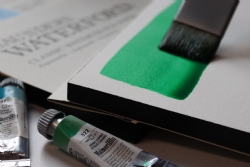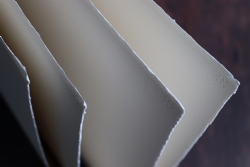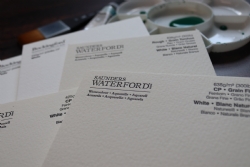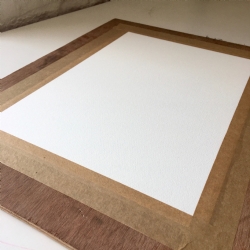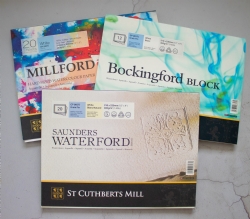St Cuthberts Mill Paper
Call or email:
+44 (0)1749 672015
sales@stcuthbertsmill.com
St Cuthberts Mill Paper
Watercolour
Printmaking
Digital Fine Art
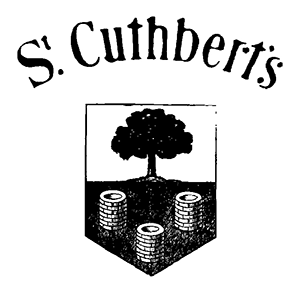
How to Keep Paper Flat
Watercolour is a demanding technique for paper. Getting the right paper to work well under pressure will help the painting process. With watercolour, there are times when large amounts of water need to be added to the sheet, and ideally you want it to RESIST any unsightly buckling as the paper cockles.
Why do papers buckle when water is applied?
Paper is made up of thousands of fibres that are compressed together to form a sheet. These fibres swell when water is added to the surface. It is important to note that there are distinct differences between Mould Made papers and Fourdrinier Made papers when water is applied to the surface due to the differences in how their fibres are distributed.
Why are Mould Made papers better at staying flatter?
Inside a sheet of Mould Made paper the fibres are mostly randomly distributed, this means the fibres swell in both directions when the paper gets wet, reducing the amount of buckling on the surface of the sheet. Whilst with Fourdrinier Made paper, the fibres tend lie in one direction, so when the fibres get wet the swelling is in one direction, this gives more unsightly buckling. With Mould Made papers the sheet has superior dimensional stability than paper made on a Fourdrinier paper machine, leading to quality artist papers being better suited to a Mould Made manufacturing process.
Will Mould Made papers always stay flat?
Using a Mould Made paper will not guarantee the paper will always remain flat. Mould Made paper will just ensure the paper will be flatter, despite the water applied to the surface. There are other techniques you can use to make sure the paper stays unbuckled and cockle free.
Heavy weight paper resists buckling
The heavier the weight of the paper, the more natural resistance it has for cockling. As a general rule:
190gsm (90lb) Will always experience some curl, even with dry brush work
300gsm (140lb) With dry brush work will only have minimal curl
425gsm (200lb) A thick paper that shouldn’t curl
535gsm (250lb) A heavy paper that should stay flat, even with large washes
638gsm (300lb) A heavy paper that should stay flat, even with large washes
Soaking and stretching paper
The act of soaking a paper and letting it dry naturally tapped to a board, to ‘stretch’ the paper out, will guarantee the sheet will remain flat. You can confidently use a lighter weight 190gsm or a 300gsm paper, that has been pre stretched with lots of water, as it will remain buckle free, because it stays tightly stretched to the board.
To learn how to Soaking and Stretching Watercolour Paper
This is a technique that has to be done a day or so in advance, and can be prone to some difficulties. We have tips to overcome some common issues Soaking and Stretching - Problem Solving
Using blocks – 4 sides are glued
In additional to the traditional pads that are glued along one edge, there are also ‘Blocks’. These are glued along all four sides and are designed to be painted directly onto. The glued edges act similar to the paper being soaked and stretched. Once the painting is dry, the paper should be flat and can be released from the top of the block by sliding a blunt knife under the sheet and slicing the glue holding it in place.
Checklist of items to assist keeping your paper flat:
• Look for Mould Made paper
• Heavy weight sheets 425gsm and higher
• Soak and stretch a sheet of paper
• Use ‘Blocks’ that are glued on 4 edges
All the papers made at St Cuthberts Mill are Mould Made, so have a natural ability to stay flatter, due to their superior surface stability. In addition, there are heavy weight sheets in the Bockingford® range with a 425gsm (200lb) and 535gsm (250lb) sheets available. With Saunders Waterford® there are 425gsm (200lb) papers and a very heavy 638gsm (300lb) papers. There are also Blocks in the Bockingford®, Saunders Waterford® and Millford series of watercolour papers.
Related articles
What is Mould Made?
Secrets of Why Mould Made Papers Stay Flatter

